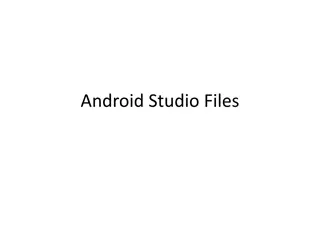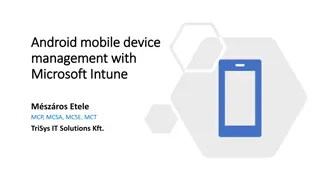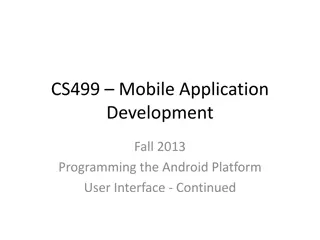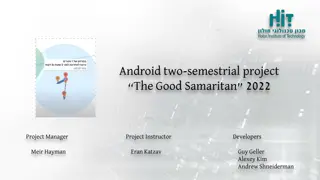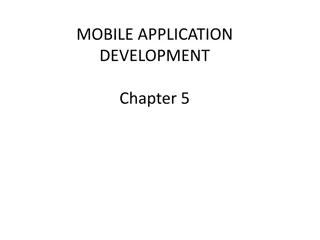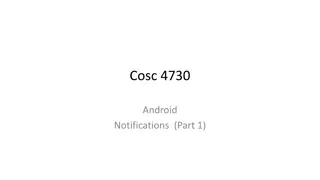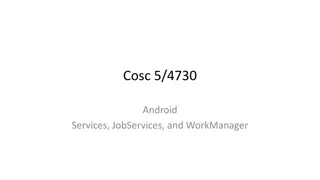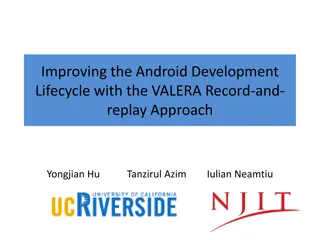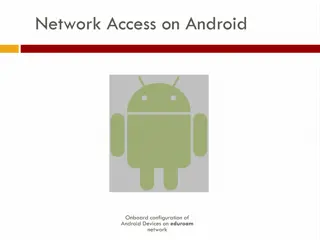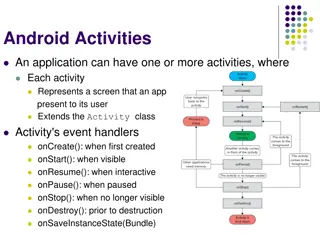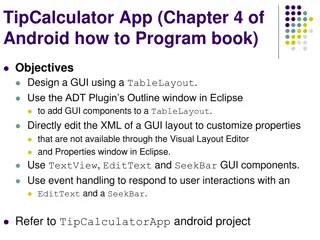Understanding Android Application Life Cycle
Exploring the various stages of the Android Activity Life Cycle, from onCreate to onDestroy. Learn how each stage plays a crucial role in managing system resources and user interactions within an Android application. Dive into Views and XML usage in the Eclipse IDE for Android development.
Download Presentation

Please find below an Image/Link to download the presentation.
The content on the website is provided AS IS for your information and personal use only. It may not be sold, licensed, or shared on other websites without obtaining consent from the author. Download presentation by click this link. If you encounter any issues during the download, it is possible that the publisher has removed the file from their server.
E N D
Presentation Transcript
Android By Collin Donaldson With Strong Contributions From: Anthony Kopczyk
Activity Life Cycle - onCreate Set the Activity's content View; Event Listeners Find references to any needed Views Passed-in Bundle allows a programmer to restore the Activity to its previous status
Activity Life Cycle - onStart Called when the Activity becomes visible Initialize any properties requiring information from the Window and contained Views
Activity Life Cycle - onResume Called when the Activity is visible and in the foreground Initialize ability for user to interact with the Activity
Activity Life Cycle - onPause Called when the Activity is no longer the foreground Release system resources
Activity Life Cycle - onStop Called when Activity is no longer visible Perform larger operations like writing to a database Save Activity's state for onStart
Activity Life Cycle - onDestroy Called when the system is in need of resources Last chance to free resources and avoid memory leaks
Views A building block for UI components Responsible for drawing and event handling Each View has an id findViewById(int) Text box, check box, radio button, time picker, and image view
XML Eclipse IDE Uses XML files to set up the mobile application Android Layout File
XML - Android Manifest Contains properties of the application Permissions, SDK, Icon, Activities Android Manifest File
XML - Layout Defines the layout of the Activity Set View id values Could achieve the same results through java code Android Layout File
XML Other Files Menu Defines the Menu to bring up Dimens Defines dimensions with names and values Strings Defines strings with names and values Lint Defines exclusion or customization of lint checks Styles Defines the style to use in the Activity Attrs Defines custom attributes that may be used in XML Layout files
Input Events OnClickListener OnLongClickListener OnFocusChangeListener OnKeyListener OnTouchListener OnCreateContextMenuListener
Input Events Pre-Click Post-Click
Intents Starts an activity or service Service operates in the background without a UI Intents can be sent to other Apps sendBroadcast() sendOrderedBroadcast( ) sendStickyBroadcast()
Intents Explicit vs. Implicit Explicit Intents specify a component to start. Implicit Intents give a general action to perform.
Intents - Intent-Filter Specified in the Manifest file Contains the types of Intents the app wants to receive Allows one app to send an Intent to another If no intent filters are specified the activity may only be started with an explicit Intent To ensure security, always use explicit intents when starting a Service Users can not see when a Service starts
Permission Allows developers to use security features Provides additional capabilities to consumers that otherwise would be impossible A central design point of the Android security architecture is that no application, by default, has permission to perform any operations that would adversely impact other applications, the operating system, or the user
Permission When an Application is installed the consumer must accept the permissions requested by an application Permissions are defined in the Manifest file
Permission Facebook Messenger Angry Birds Identity Identity Contacts/Calendar In-app purchases Location Location SMS Photos/Media/Files Phone Wi-Fi Connection Information Photos/Media/Files Device ID & Call Information Camera/Microphone Wi-Fi Connection Information Device ID & Call Information
Permission Camera/Microphone Allows consumers to use video chat Photos/Media/Files Allows consumers to send pictures they have previously taken In order to give access, one must become more vulnerable like opening ports on your router
Permission Using Intents and Permissions a developer can make his/her app call a phone number.
Permission Activity Class
Permission Manifest File
Rooting/JailBreaking Rooting is the process of gaining root (a.k.a. administrator or super user) to a smartphone. By default, all smartphones only give user s guest privileges. This is for both safety reasons and to prevent users from doing things developers/carriers don t like (i.e. getting rid of their bloatware).
Pros and Cons to Root Pros Download more apps and use existing apps to fullest potential Flash custom ROMs Access locked hardware/software features Tune performance No more bloatware Wi-Fi/Bluetooth Tethering Use apps designed for other phones/carriers Install apps to an SD card Cons If done incorrectly, can possibly brick phone Voids any warranties you have (even if you reverse the root) Less stable/more bugs
General Security Vulnerabilities Flaws in Android OS itself Flaws in phone software/firmware Conventional browser based virus Vulnerabilities within downloaded apps Unconventional attacks (injecting code into accelerometers i.e.)
Specific Vulnerabilities Backdoor.AndroidOS.Obad.a does not have an interface and works in background mode, making it difficult to analyze, but that was only part of the challenge, according to Unuchek. The application exploits an error in the DEX2JAR software generally used by researchers to convert APK files into the Java Archive (JAR) format) that disrupts the conversion of Dalvik bytecode into Java bytecode and makes it difficult to run a statistical analysis of the Trojan. Obad.a also targets an error in Android s processing of the AndroidManifest.xml file, which exists in every Android application to describe the application s structure, define its launch parameters and more. Although Obad.a modifies AndroidManifest.xml so that it doesn t comply with Google standards, the vulnerability enables it to still be processed correctly, complicating any attempt to run dynamic analysis on the application.
Next Time We will use a Metasploit (with a specific module) to attack an android device. The android device will be a virtual android machine running on an emulator We may also write a virus and Python and deploy it to a device.


